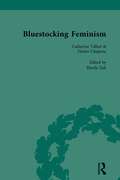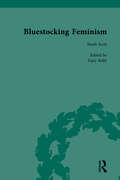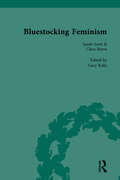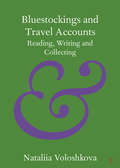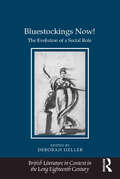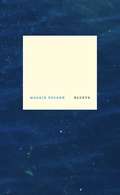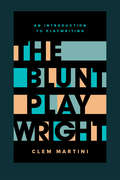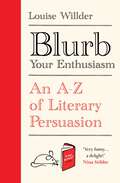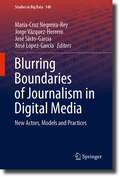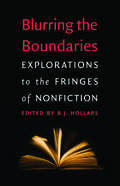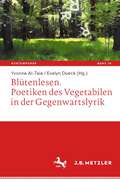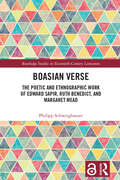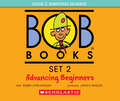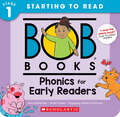- Table View
- List View
Bluestocking Feminism, Volume 3: Writings of the Bluestocking Circle, 1738-93
by Gary Kelly Elizabeth Eger Judith Hawley Jennifer Kelly Rhoda ZukFeminist scholarship and criticism has retrieved the Bluestocking women from their marginal position in 18th-century literature. This work collects the principal writings of these women, together with a selection of their letters. Each volume is annotated and all texts are edited and reset.
Bluestocking Feminism, Volume 4: Writings of the Bluestocking Circle, 1738-94
by Gary Kelly Elizabeth Eger Judith Hawley Jennifer Kelly Rhoda ZukFeminist scholarship and criticism has retrieved the Bluestocking women from their marginal position in 18th-century literature. This work collects the principal writings of these women, together with a selection of their letters. Each volume is annotated and all texts are edited and reset.
Bluestocking Feminism, Volume 5: Writings of the Bluestocking Circle, 1738-95
by Gary Kelly Elizabeth Eger Judith Hawley Jennifer Kelly Rhoda ZukFeminist scholarship and criticism has retrieved the Bluestocking women from their marginal position in 18th-century literature. This work collects the principal writings of these women, together with a selection of their letters. Each volume is annotated and all texts are edited and reset.
Bluestocking Feminism, Volume 6: Writings of the Bluestocking Circle, 1738-96
by Gary Kelly Elizabeth Eger Judith Hawley Jennifer Kelly Rhoda ZukFeminist scholarship and criticism has retrieved the Bluestocking women from their marginal position in 18th-century literature. This work collects the principal writings of these women, together with a selection of their letters. Each volume is annotated and all texts are edited and reset.
Bluestockings and Travel Accounts: Reading, Writing and Collecting (Elements in Publishing and Book Culture)
by Nataliia VoloshkovaThis Element proposes to relate the eighteenth-century world of travel and travel writing with the bluestocking salon. It locates eminent British travellers and explorers in the female-presided intellectual space and examines their multifaceted interaction with the bluestockings between 1760 and 1799. The study shows how the bluestockings acquired knowledge of the world through reading, discussing, writing and collecting travel accounts. It explores the 'social life' of manuscript and printed travel texts in the circle, their popularity and impact on the bluestockings. This Element builds upon the body of evidence provided by their published and unpublished diaries, correspondence and private library catalogues.
Bluestockings Displayed
by Elizabeth EgerThe conversation parties of the bluestockings, held to debate contemporary ideas in eighteenth-century Britain, were vital in encouraging female artistic achievement. The bluestockings promoted links between learning and virtue in the public imagination, inventing a new kind of informal sociability that combined the life of the senses with that of the mind. This collection of essays, by leading scholars in the fields of literature, history and art history, provides an interdisciplinary treatment of bluestocking culture in eighteenth-century Britain. It is the first academic volume to concentrate on the rich visual and material culture that surrounded and supported the bluestocking project, from formal portraits and sculptures to commercially reproduced prints. By the early twentieth century, the term 'bluestocking' came to signify a dull and dowdy intellectual woman, but the original bluestockings inhabited a world in which brilliance was valued at every level and women were encouraged to shine and even dazzle.
Bluestockings Now!: The Evolution of a Social Role (British Literature in Context in the Long Eighteenth Century)
by Deborah HellerBringing together top specialists in the field, this edited volume challenges the theory that the eighteenth-century British intellectual women known as the Bluestockings were an isolated phenomenon spanning the period from the 1750s through the 1790s. On the contrary, the contributors suggest, the Bluestockings can be conceptualized as belonging to a chain of interconnected networks, taking their origin at a threshold moment in print media and communications development and extending into the present. The collection begins with a definition of the Bluestockings as a social role rather than a fixed group, a movement rather than a static phenomenon, an evolving dynamic reaching into our late-modern era. Essays include a rare transcript of a Bluestocking conversation; new, previously unknown Bluestockings brought to light for the first time; and descriptions of Bluestocking activity in the realms of natural history, arts and crafts, theatre, industry, travel, and international connections. The concluding essay argues that the Blues reimagined and practiced women’s work in ways that adapted to and altered the course of modernity, decisively putting a female imprint on economic, social, and cultural modernization. Demonstrating how the role of the Bluestocking has evolved through different historical configurations yet has structurally remained the same, the collection traces the influence of the Blues on the Romantic Period through the nineteenth century and proposes the reinvention of Bluestocking practice in the present.
Bluets
by Maggie NelsonSuppose I were to begin by saying that I had fallen in love with a color . . .A lyrical, philosophical, and often explicit exploration of personal suffering and the limitations of vision and love, as refracted through the color blue. With Bluets, Maggie Nelson has entered the pantheon of brilliant lyric essayists.Maggie Nelson is the author of numerous books of poetry and nonfiction, including Something Bright, Then Holes (Soft Skull Press, 2007) and Women, the New York School, and Other True Abstractions (University of Iowa Press, 2007). She lives in Los Angeles and teaches at the California Institute of the Arts.
The Blunt Playwright: An Introduction to Playwriting
by Clem MartiniThe Blunt Playwright won’t tell you everything there is to know about playwriting. It won’t even try. What it will do is examine process, structure, dialogue, and character; provide classic and contemporary scenes to study; outline clever exercises to strengthen writing skills; and so much more. Highly regarded and used in schools everywhere, this updated edition cements its place as one of the best resources for playwrights. From organizing the structure of a script to developing characters’ voices, from employing visual effects on stage to writing comedy, or from self-promotion to getting produced and published, this guide has something for everyone, no matter the stage of their career.
Blurb Your Enthusiasm: An A-Z of Literary Persuasion
by Louise Willder&‘The bookiest book about books you&’ll ever read – I loved it&’ Lucy Mangan &‘Truly delightful...I couldn&’t have had more fun&’ Benjamin Dreyer &‘Very funny, erudite and profound. A delight!&’ Nina Stibbe This is the outside story of books. From blurbs to titles, quotes to (checks jacket) cute animal designs – via author feuds, writing tricks, classic literature, bonkbusters, plot spoilers and publishing secrets – discover why it&’s good to judge a book by its cover. Maybe even this one…
Blurring Boundaries of Journalism in Digital Media: New Actors, Models and Practices (Studies in Big Data #140)
by María-Cruz Negreira-Rey Jorge Vázquez-Herrero José Sixto-García Xosé López-GarcíaWhat changes have affected the definition of the boundaries of journalism in the last decade? How do technologies influence the boundaries of journalism? Are threats and opportunities identified in those blurred areas of journalism? The aim of this book is to answer these questions and to address, from different perspectives, the redefinition of the boundaries of journalism according to the most recent changes in digital media concerning actors, models, and practices.More than 40 authors from eleven countries contribute to this book, which is structured into six sections to analyze the principles of journalism today, sustainability strategies in the digital context, old and new actors, formats and narratives, adaptation to the mobile scenario and to social platforms, and the changes introduced by artificial intelligence. Undoubtedly, this book is of interest to both academics and professionals, as well as a crucial reference for scholars and students of media and journalism.Chapter 7 is available open access under a Creative Commons Attribution 4.0 International License via link.springer.com.
Blurring the Boundaries: Explorations to the Fringes of Nonfiction
by B. J. HollarsContemporary discussions on nonfiction are often riddled with questions about the boundaries between truth and memory, honesty and artifice, facts and lies. Just how much truth is in nonfiction? How much is a lie? Blurring the Boundaries sets out to answer such questions while simultaneously exploring the limits of the form. This collection features twenty genre-bending essays from today’s most renowned teachers and writers—including original work from Michael Martone, Marcia Aldrich, Dinty W. Moore, Lia Purpura, and Robin Hemley, among others. These essays experiment with structure, style, and subject matter, and each is accompanied by the writer’s personal reflection on the work itself, illuminating his or her struggles along the way. As these innovative writers stretch the limits of genre, they take us with them, offering readers a front-row seat to an ever-evolving form. Readers also receive a practical approach to craft thanks to the unique writing exercises provided by the writers themselves. Part groundbreaking nonfiction collection, part writing reference, Blurring the Boundaries serves as the ideal book for literary lovers and practitioners of the craft.
Blütenlesen. Poetiken des Vegetabilen in der Gegenwartslyrik (Kontemporär. Schriften zur deutschsprachigen Gegenwartsliteratur #16)
by Yvonne Al-Taie Evelyn DueckLieß Brechts zum Diktum gewordenes Versfragment «Gespräch über Bäume» die Naturlyrik zum fragwürdigen Genre werden, so rief es gleichwohl bald Widerspruch hervor, nicht nur in Paul Celans lyrischer Replik «Ein Blatt, baumlos» und den ebenfalls auf Brecht antwortenden Gedichten Erich Frieds und Günter Eichs, sondern auch in der engagierten ökokritischen Dichtung seit den 1970er Jahren. Während das «Gespräch über Bäume» vor allem auf Natur und Landschaft als Gegenstand und Thema von Dichtung bezogen ist, fragt dieser Sammelband, wie das gegenwärtige Interesse an der Natur mit Formfragen und deren poetologischen Reflexionen in der deutschsprachigen Lyrik seit den 1990er Jahren einhergeht. Wie verbinden sich diese Formfragen und ihre poetologischen Reflexionen in der Gegenwart mit einem diachron weitgefassten Blick auf Ornamente und Schreibweisen wie Arabesken und Grotesken, Gattungsbezeichnungen wie Silven oder Florilegien, arboreale und mykologische Strukturmodelle wie Baumdiagramme, Rhizome oder Myzele, die auf vegetabile Formvorbilder zurückgreifen? Wie lassen sich diese Darstellungen des Vegetabilen in der Dichtung auf naturwissenschaftliche Verfahren der Sichtbarmachung oder das morphologische und botanische Wissen über Bau- und Formprinzipien der Pflanzen beziehen? Von diesen Beobachtungen ausgehend fragen die Beiträge dieses Bandes, welche Poetologien des Vegetabilen die deutschsprachige Gegenwartslyrik ausgebildet hat und wie sich darin botanisches Wissen, medienkritisches Bewusstsein und ästhetisches Naturerleben zu neuen dichterischen Formen verschränken.
Boasian Verse: The Poetic and Ethnographic Work of Edward Sapir, Ruth Benedict, and Margaret Mead (Routledge Studies in Twentieth-Century Literature)
by Philipp SchweighauserBoasian Verse explores the understudied poetic output of three major twentieth-century anthropologists: Edward Sapir, Ruth Benedict, and Margaret Mead. Providing a comparative analysis of their anthropological and poetic works, this volume explores the divergent representations of cultural others and the uses of ethnographic studies for cultural critique. This volume aims to illuminate central questions, including: • Why did they choose to write poetry about their ethnographic endeavors? • Why did they choose to write the way they wrote? • Was poetry used to approach the objects of their research in different, perhaps ethically more viable ways? • Did poetry allow them to transcend their own primitivist, even evolutionist tendencies, or did it much rather refashion or even amplify those tendencies? This in-depth examination of these ethnographic poems invites both cultural anthropologists and students of literature to reevaluate the Boasian legacy of cultural relativism, primitivism, and residual evolutionism for the twenty-first century. This volume offers a fresh perspective on some of the key texts that have shaped twentieth- and twenty-first-century discussions of culture and cultural relativism, and a unique contribution to readers interested in the dynamic area of multimodal anthropologies.
The Boat Alphabet Book (Jerry Pallotta's Alphabet Books)
by Jerry PallottaAhoy, mateys! Get on board! Boats and the need for them have been around for thousands of years. Reed boats might have been the first boat ever to be built. The Vikings built wooden ships that were strong and ornate. And now boats like an Aircraft Carrier house 6,000 people and can carry over 100 planes. In Jerry Pallotta's newest book we get to see an entire alphabet of floating wonders. David Biedrzycki has provided dramatic settings for a variety of boats and captures the mood of each body of water. In one he paints a calm lake where a red canoe glides across the water and in another the stormy swells of an angry ocean tossing a three-masted Xebec. The facts about each boat are sprinkled with traditional Pallotta humor.
The Boatman: Henry David Theoreau's River Years
by Robert M. ThorsonRobert Thorson gives readers a Thoreau for the Anthropocene. The boatman and backyard naturalist was keenly aware of the way humans had altered the waterways and meadows of his beloved Concord River Valley. Yet he sought out for solace and pleasure those river sites most dramatically altered by human invention and intervention—for better and worse.
Bob Books - Advancing Beginners | Phonics, Ages 4 and up, Kindergarten: Advancing Beginners (Bob Books)
by Bobby Lynn MaslenCreated by a teacher, Bob Books have been helping children learn to read for more than forty years! This phonics-based learn-to-read set is perfect for young readers who are still building their skills.Bob Books Advancing Beginners builds on the skills learned in the Bob Books Stage 1 sets. These twelve stories are slightly longer while still using three-letter words and consistent short vowel sounds. This develops the confidence of young readers and helps ensure that they master basic phonics before moving on to more complex skills. Kids love the fun, drama, and surprise in these stories and pictures!In this collection you'll find:12 easy-to-read, hilarious stories: 16 pages each, 17-41 unique words per storyA parent guide with tips for helping your child learn to readEach story includes:Decodable text: Three-letter words with short vowels that can be sounded out (big, sun, cap)Simple sentences (Pop had a top hat.)Limited sight words (a, the, was)Slighter longer stories than in the Stage 1 sets, which helps build reading enduranceA word list at the back of each bookFriendly, simple illustrations that add fun and do not distract from the wordsGuided Reading Levels: C, D, E | Lexile Measure: BR - 380L | Bob Books Level: Stage 2Ages: 4-6 | Grade Levels: Kindergarten, First GradeBob Books' phonics-based method aligns with the body of research known as the Science of Reading, which proves that systematic phonics instruction is crucial to children's reading success. With simple phonics, playful stories, and silly illustrations, Bob Books keep young readers' confidence high, leading to continued success and a love of reading. Your child will soon join the millions of happy kids who say, "I read the whole book!"
Bob Books - Animal Stories | Phonics, Ages 4 and up, Kindergarten (Bob Books)
by Lynn Maslen KertellCreated by a teacher, Bob Books have been helping children learn to read for more than forty years! This set of phonics-based, easy-to-read stories features silly animal characters -- perfect for kids in kindergarten and first grade.Bob Books Animal Stories are full of fun animal characters, from a pig who is a picky eater to a rabbit who loves to dress up! These charming books engage young readers while they practice their reading skills. Each story uses one-syllable words with consistent short vowels, which keeps text decodable and builds kids' confidence. Longer animal names and sight words sprinkled throughout add just the right amount of challenge.Inside this collection you'll find:12 small, hilarious, easy-to-read books: 12 pages each, 18-28 unique words per storyA parent guide with tips for helping your child learn to readEach story includes:Decodable text: Mostly three- and four-letter words with short vowels that can be sounded out (eggs, mop, slug)Simple sentences (Pig has buns and jam.)Limited sight words (saw, car, mouse)Friendly, simple illustrations that add fun and do not distract from the wordsGuided Reading Levels: C, D, E, F | Lexile® Measure: 60L - 270L | Bob Books Level: Stage 2Ages: 4-6 | Grade Levels: Kindergarten, First GradeBob Books' phonics-based method aligns with the body of research known as the Science of Reading, which proves that systematic phonics instruction is crucial to children's reading success. With simple phonics, playful stories, and silly illustrations, Bob Books keep young readers' confidence high, leading to continued success and a love of reading. Your child will soon join the millions of happy kids who say, "I read the whole book!"®
Bob Books - Complex Words | Phonics, Ages 4 and up, Kindergarten, First Grade: Complex Words (Bob Books)
by Bobby Lynn MaslenCreated by a teacher, Bob Books have been helping children learn to read for more than forty years! This phonics-based set gives young readers the practice they need to advance to more complex words and sentences.Developing readers will love these fun stories! While Bob Books Complex Words still uses short vowels and repetition to keep the text decodable, the longer books in this phonics-based learn-to-read set introduce more complex words, new long vowel teams, and word endings such as -ed and -ly. The playful stories engage kids and provide a new challenge to advance their skills.In this collection you'll find:8 small, hilarious, easy-to-read books: 16-24 pages each, 12-78 unique words per bookA parent guide with tips for helping your child learn to readEach book includes:Repetition of words and sounds, which helps children decode the textSimple sentences with more complex words ("Jim slipped into the pond.")A list of new consonant blends and vowel combinations introduced in that bookFriendly, simple illustrations that add fun and do not distract from the wordsGuided Reading Levels: E, F, G | Lexile Measure: 60L - 490L | Bob Books Level: Stage 3Ages: 4-6 | Grade Levels: Kindergarten, First GradeBob Books' phonics-based method aligns with the body of research known as the Science of Reading, which proves that systematic phonics instruction is crucial to children's reading success. With simple phonics, playful stories, and silly illustrations, Bob Books keep young readers' confidence high, leading to continued success and a love of reading. Your child will soon join the millions of happy kids who say, "I read the whole book!®
Bob Books - First Stories | Phonics, Ages 4 and up, Kindergarten (Bob Books)
by Lynn Maslen KertellCreated by a teacher, Bob Books have been helping children learn to read for more than forty years! This charming phonics set features simple stories that get progressively more challenging. Bob Books First Stories is the perfect introduction to independent reading! With lots of repetition, friendly illustrations, and silly stories, these phonics-based books are great for kids just starting to read. They can be enjoyed on their own, or alongside Bob Books Beginning Readers and Bob Books More Beginning Readers.In this collection you'll find:12 easy-to-read, hilarious stories: 12 pages each, 6-26 unique words per storyA parent guide with tips for helping your child learn to readEach story includes:Decodable text: Three- and four-letter words with short vowels that can be sounded out (ran, hop, went, trap)Very simple sentences (Sam and Mat can hop.)Limited sight words (the, do, was)Friendly, simple illustrations that add fun and do not distract from the wordsGuided Reading Levels: A, B, C | Lexile Measure: BR - 280L | Bob Books Level: Stage 1Ages: 4-6 | Grade Levels: PreK, KindergartenBob Books' phonics-based method aligns with the body of research known as the Science of Reading, which proves that systemic phonics instruction is crucial to children's reading success. With simple phonics, playful stories, and silly illustrations, Bob Books keep young readers' confidence high, leading to continued success and a love of reading. Your child will soon join the millions of happy kids who say, "I read the whole book!®
Bob Books - Long Vowels Hardcover Bind-Up | Phonics, Ages 4 and up, Kindergarten, First Grade: Long Vowels (Bob Books)
by Bobby Lynn MaslenCreated by a teacher, Bob Books have been helping children learn to read for more than forty years! This phonics-based set introduces long vowels and helps developing readers gently take the final step toward reading chapter books. Now in a sturdy hardcover!The silly stories in Bob Books Long Vowels focus on long vowels, but also provide plenty of practice with silent e, longer words, and word endings such as -ed and -ing. The longer stories build reading endurance and expand the vocabulary of maturing readers. This set prepares kids to graduate to chapter books!In this collection you'll find:8 hilarious, easy-to-read books: 16-24 pages each, 52-129 unique words per bookA parent guide with tips for helping your child learn to readEach book includes:Repetition of words and sounds, which helps children decode the textLonger sentences and stories than previous sets ("She ran as fast as she could.")A list of new long vowel combinations introduced in that bookFriendly, simple illustrations that add fun and do not distract from the wordsGuided Reading Levels: G, H, I | Lexile Measure: 110L - 560L | Bob Books Level: Stage 3Ages: 4-6 | Grade Levels: Kindergarten, First GradeBob Books' phonics-based method aligns with the body of research known as the Science of Reading, which proves that systematic phonics instruction is crucial to children's reading success. With simple phonics, playful stories, and silly illustrations, Bob Books keep young readers' confidence high, leading to continued success and a love of reading. Your child will soon join the millions of happy kids who say, "I read the whole book!"®
Bob Books - More Beginning Readers | Phonics, Ages 4 and up, Kindergarten (Bob Books)
by Lynn Maslen KertellCreated by a teacher, Bob Books have been helping children learn to read for more than forty years! This phonics-based set is perfect for kids who need practice at a very beginning reading level.Bob Books More Beginning Readers gives early readers more support with beginning phonics skills, reinforcing what they learned in Bob Books Beginning Readers. This set can also be read on its own by any child just learning to read. The silly stories use three-letter words, short sentences, and plenty of repetition to keep the text simple and decodable, helping kids become comfortable and confident with basic reading!In this collection you'll find:12 small, hilarious, easy-to-read stories: 12 pages each, 8-25 unique words per storyA parent guide with tips for helping your child learn to readEach story includes:Decodable text: Three-letter words with short vowels that can be sounded out (cat, bag, fox, bed)Very simple sentences (Sam can pat.)Very limited sight words (a, go, the)Friendly, simple illustrations that add fun and do not distract from the wordsGuided Reading Levels: C, D | Lexile® Measure: BR10L - 90L | Bob Books Level: Stage 1Ages: 4-6 | Grade Levels: PreK, KindergartenBob Books' phonics-based method aligns with the body of research known as the Science of Reading, which proves that systematic phonics instruction is crucial to children's reading success. With simple phonics, playful stories, and silly illustrations, Bob Books keep young readers' confidence high, leading to continued success and a love of reading. Your child will soon join the millions of happy kids who say, "I read the whole book!"®
Bob Books - Phonics for Early Readers | Phonics, Ages 4 and up, Kindergarten (Bob Books)
by Liza CharlesworthCreated by a teacher, Bob Books have been helping children learn to read for more than forty years! This set gives a beginning reader practice with basic phonics skills, setting them up for a successful reading journey.With playful stories, silly illustrations, and a phonics approach based on Science of Reading research, Bob Books keep young readers' confidence high, leading to continued success and a love of reading. Your child will soon join the millions of happy kids who say, "I read the whole book!"®Science of Reading research proves that mastering phonics is key to a child's success in learning to read. Like all Stage 1 Bob Books, these 12 storybooks feature simple words with consistent short vowel sounds. Early readers get lots of practice with foundational phonics skills while giggling at the playful stories and pictures!This set is perfect for children who have never read Bob Books, or for children who have read Bob Books Beginning Readers or Bob Books More Beginning Readers and need more practice before moving on.In this collection you'll find:12 easy-to-read, hilarious stories: 12 pages each, 14-25 unique words per storyA parent guide with tips for helping your child learn to readEach book includes:Decodable text: Two- and three-letter words with short vowels that can be sounded out (cat, it, not, up)Very simple sentences (Sam has a pen.)Very limited sight words (a, of, the)Friendly, simple illustrations that add fun and do not distract from the wordsGuided Reading Levels: B, C | Lexile® Measure: 0 - 130L | Bob Books Level: Stage 1Ages: 4-6 | Grade Levels: PreK, Kindergarten
Bob Books - Rhyming Words | Phonics, Ages 4 and up, Kindergarten, Flashcards (Bob Books)
by Lynn Maslen KertellCreated by a teacher, Bob Books have been helping children learn to read for more than forty years! This fun set of easy-to-read stories focuses on rhyming words-perfect for beginning readers.Rhyming makes reading more fun! Each story in this phonics-based box set explores a different rhyming word family. Listening for and identifying rhyming words is an important early reading activity because it trains a child's ear to hear the differences and similarities in how words sound. The repetition of rhyming sounds in these silly stories helps early readers sound out the one-syllable words. This collection is a great companion to Bob Books Beginning Readers and Bob Books First Stories.In this collection you'll find:10 easy-to-read, hilarious stories: 12 pages each, 15-23 unique words per storyA parent guide with tips for helping your child learn to readEach story includes:A new rhyming word family (AN: can, Dan, fan, plan, ran)Decodable text: three- and four-letter rhyming words with short vowels that can be sounded outSimple sentences (The red sled sped.)Limited sight words (a, now, for)Friendly, simple illustrations that add fun and do not distract from the wordsGuided Reading Levels: C, D, E | Lexile Measure: 30L - 360L | Bob Books Level: Stage 1Ages: 4-6 | Grade Levels: PreK, KindergartenBob Books' phonics-based method aligns with the body of research known as the Science of Reading, which proves that systematic phonics instruction is crucial to children's reading success. With simple phonics, playful stories, and silly illustrations, Bob Books keep young readers' confidence high, leading to continued success and a love of reading. Your child will soon join the millions of happy kids who say, "I read the whole book!"®
Bob Books - Set 1: Beginning Readers (Bob Books)
by Bobby Lynn MaslenCreated by a teacher, Bob Books have been helping children learn to read for more than forty years. This iconic phonics-based learn-to-read set has sold millions of copies, allowing children around the world to say with pride, "I read the whole book!"®Perfect for children who are just learning letter sounds, each book in this set contains two- and three-letter words that can be sounded out. The first story uses only four sounds (M, A, T, S) and one sight word! Sounds are added gradually until all letters of the alphabet have been introduced (except q). The very simple stories and funny pictures allow kids to read a whole book and build their confidence. Kids can't wait to read these books to everyone they know!Inside you'll find:12 small, hilarious, easy-to-read stories: 12 pages each, 4-27 unique words per bookA parent guide with tips for helping your child learn to readEach story includes:Decodable text: Two- and three-letter words with short vowels that can be sounded out (on, sat, can, ran)Very simple sentences (Sam sat.)Very limited sight words (a, the)New letter sounds added gradually until young readers have read books with all letters of the alphabet (except q)Friendly, simple illustrations that add fun and do not distract from the wordsGuided Reading Levels: A, B, C | Lexile Measure: BR - 180L | Bob Books Level: Stage 1Ages: 4-6 | Grade Levels: PreK, KindergartenBob Books' phonics-based method aligns with the body of research known as the Science of Reading, which proves that systematic phonics instruction is crucial to children's reading success. With simple phonics, playful stories, and silly illustrations, Bob Books keep young readers' confidence high, leading to continued success and a love of reading. Your child will soon join the millions of happy kids who say, "I read the whole book!"®
